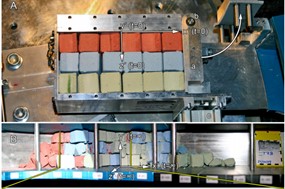Rock Avalanche Simulator
The rock avalanche (sturzstrom) simulator is designed to expose two litres of rock to a stress and kinetic energy regime comparable to that of true sturzstroms (Imre 2010). Not intended to scale masses and dimensions completely, it allows simulation of an environment of virtual unconfined run out in the direction of the x´-axis, under plane strain conditions in the y´-axis, a free surface in the +z´-direction, and a smooth sliding surface in the -z´-direction.
The experimental setup includes: (a) a 2lt capacity hopper, inclined at 12° to the radius of the drum; (b) an acceleration chute of 0.325 m radius; (c) a runout chute of 1.06 m radius; (d) a compressed air tank; (e) tool platform; (f) drum channel; (g) high speed camera; (h) lighting system; and (i) data acquisition box. To maintain balance of the centrifuge, two experiments are performed at the same time at diametrically opposed channel sections.

A trap door is used to release the material, triggered via an electromagnetic valve, which opens the air flow to the pneumatic pistons of the hopper. Large air intake lids are installed opposite the trap doors to prevent depression of air pressure while the blocks leave the hoppers. Three light barriers are installed at the end of the channel to measure the front velocity of the rock slide (by detecting disturbance of the light beam). Three 0.416 m long run out segments are located adjacent to the acceleration chute. The first one is instrumented with a combined temperature and 3-axial force sensor, and equipped with a side window that allows observation of the sliding rock material using a high speed camera.

